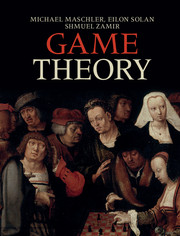Book contents
- Frontmatter
- Contents
- Acknowledgments
- Notations
- Introduction
- 1 The game of chess
- 2 Utility theory
- 3 Extensive-form games
- 4 Strategic-form games
- 5 Mixed strategies
- 6 Behavior strategies and Kuhn's Theorem
- 7 Equilibrium refinements
- 8 Correlated equilibria
- 9 Games with incomplete information and common priors
- 10 Games with incomplete information: the general model
- 11 The universal belief space
- 12 Auctions
- 13 Repeated games
- 14 Repeated games with vector payoffs
- 15 Bargaining games
- 16 Coalitional games with transferable utility
- 17 The core
- 18 The Shapley value
- 19 The bargaining set
- 20 The nucleolus
- 21 Social choice
- 22 Stable matching
- 23 Appendices
- References
- Index
7 - Equilibrium refinements
- Frontmatter
- Contents
- Acknowledgments
- Notations
- Introduction
- 1 The game of chess
- 2 Utility theory
- 3 Extensive-form games
- 4 Strategic-form games
- 5 Mixed strategies
- 6 Behavior strategies and Kuhn's Theorem
- 7 Equilibrium refinements
- 8 Correlated equilibria
- 9 Games with incomplete information and common priors
- 10 Games with incomplete information: the general model
- 11 The universal belief space
- 12 Auctions
- 13 Repeated games
- 14 Repeated games with vector payoffs
- 15 Bargaining games
- 16 Coalitional games with transferable utility
- 17 The core
- 18 The Shapley value
- 19 The bargaining set
- 20 The nucleolus
- 21 Social choice
- 22 Stable matching
- 23 Appendices
- References
- Index
Summary
Chapter summary
The most important solution concept in noncooperative game theory is the Nash equilibrium. When games possess many Nash equilibria, we sometimes want to know which equilibria are more reasonable than others. In this chapter we present and study some refinements of the concept of Nash equilibrium.
In Section 7.1 we study subgame perfect equilibrium, which is a solution concept for extensive-form games. The idea behind this refinement is to rule out noncredible threats, that is, “irrational” behavior off the equilibrium path whose goal is to deter deviations. In games with perfect information, a subgame perfect equilibrium always exists, and it can be found using the process of backward induction.
The second refinement, presented in Section 7.3, is the perfect equilibrium, which is based on the idea that players might make mistakes when choosing their strategies. In extensive-form games there are two types of perfect equilibria corresponding to the two types of mistakes that players may make: one, called strategic-form perfect equilibrium, assumes that players may make a mistake at the outset of the game, when they choose the pure strategy they will implement throughout the game. The other, called extensive-form perfect equilibrium, assumes that players may make mistakes in choosing an action in each information set. We show by examples that these two concepts are different and prove that every extensive-form game possesses perfect equilibria of both types, and that every extensive-form perfect equilibrium is a subgame perfect equilibrium.
Information
- Type
- Chapter
- Information
- Game Theory , pp. 251 - 299Publisher: Cambridge University PressPrint publication year: 2013
